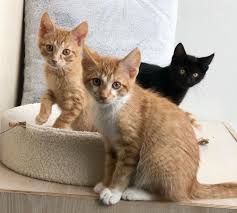Introduction
Choosing the right cat litter is essential for every cat owner, but it becomes even more critical when your cat has sensitive paws. Cats with delicate paw pads can experience discomfort, irritation, or even pain from certain types of litter, which may lead to changes in behavior such as avoiding the litter box or excessive licking of their paws. Understanding how to choose the right cat litter for cats with sensitive paws not only improves their comfort but also promotes good hygiene and overall health.
Many cats suffer quietly with paw sensitivity caused by allergies, environmental irritants, or underlying health conditions. These issues often go unnoticed because cats instinctively hide signs of discomfort. If your cat is showing signs of paw irritation or hesitates to use the litter box, it could be linked to the type of litter you are using.
This article will guide you through everything you need to know about selecting the best cat litter for cats with sensitive paws. We’ll cover the causes of paw sensitivity, types of cat litter and how they affect your cat’s paws, and practical tips for making a smooth transition to a more suitable litter. By the end, you’ll be equipped with all the information necessary to make an informed choice that keeps your furry friend happy and comfortable.
Understanding Cats with Sensitive Paws
Cats with sensitive paws often experience discomfort that can affect their daily habits and well-being. Paw sensitivity means that the cat’s paw pads are more vulnerable to irritation, inflammation, or pain compared to a typical cat. This can result from a variety of causes and understanding these is key to selecting the right cat litter.
What Does It Mean for a Cat to Have Sensitive Paws?
Sensitive paws can manifest in several ways:
- Avoidance of the litter box due to discomfort when walking or digging.
- Excessive licking or chewing of the paws, which can cause further irritation.
- Redness, swelling, or sores on the paw pads, indicating inflammation or injury.
- Changes in behavior such as reluctance to walk on certain surfaces.
Cats rely heavily on their paws for balance, hunting, and communication, so any discomfort can have a significant impact on their quality of life.
Common Causes of Paw Sensitivity in Cats
Several factors may contribute to sensitive paws, including:
- Allergies: Environmental allergens like pollen, dust, or chemicals in the litter can cause allergic reactions.
- Infections: Bacterial or fungal infections can cause inflammation and pain in the paws.
- Injuries: Cuts, burns, or foreign objects stuck in the paw pads.
- Chemical Irritants: Harsh chemicals or fragrances in some cat litters can exacerbate sensitivity.
- Underlying Health Conditions: Conditions such as autoimmune disorders or dermatological diseases.
If you notice persistent paw sensitivity, it is important to consult your veterinarian for a proper diagnosis and treatment plan.
For a detailed overview of cat paw health and common issues, visit the American Association of Feline Practitioners at catvets.com.
Types of Cat Litter and Their Suitability for Sensitive Paws
When it comes to how to choose the right cat litter for cats with sensitive paws, understanding the different types of litter available is essential. Not all litters are created equal—some are rough, dusty, or filled with chemicals that can irritate your cat’s paws. Let’s look at the most common types of cat litter and how they affect paw comfort.
Clay-Based Cat Litter (Clumping and Non-Clumping)
Clay litter, particularly clumping clay, is one of the most widely used types. It’s known for its excellent absorbency and odor control. However, it’s not always ideal for cats with sensitive paws.
Pros:
- Excellent clumping ability makes scooping easy.
- Effective odor control.
- Widely available and affordable.
Cons:
- Texture can be rough or sharp, irritating delicate paw pads.
- High dust levels, which can lead to respiratory and skin irritation.
- Often contains added fragrances or chemicals.
Verdict: Not recommended for cats with paw sensitivity, especially those prone to allergies or skin issues.
Natural and Biodegradable Cat Litters
Natural litters are made from materials like corn, wheat, walnut shells, pine, coconut husks, or recycled paper. These are often softer and less abrasive, making them a better choice for sensitive paws.
Types of Natural Litters:
- Paper-based litter (softest option, especially good for post-surgery or injury recovery).
- Corn and wheat-based litter (lightweight and biodegradable, though may trigger food allergies).
- Walnut shell litter (soft texture, though some cats may dislike its dark color).
- Pine litter (naturally antimicrobial but can be too coarse for some cats).
Pros:
- Gentler texture—ideal for sensitive paws.
- Low to no dust.
- Eco-friendly and biodegradable.
- Usually free of chemical additives and fragrances.
Cons:
- May not control odor as effectively as clay.
- More expensive in some cases.
- Some varieties may clump less effectively.
For more on eco-friendly and cat-safe litters, check out the Environmental Working Group’s Pet Health Resources at ewg.org.
Silica Gel (Crystal) Cat Litter
Silica gel litters are made from tiny beads or crystals that absorb moisture on contact.
Pros:
- Excellent odor control.
- Long-lasting—less frequent changes.
- Low dust.
Cons:
- Bead-like texture can be uncomfortable for sensitive paws.
- Some brands include artificial fragrances.
- Not biodegradable.
Verdict: May work for some cats, but not the best option for those with extreme sensitivity.
Comparison Table: Litter Type Suitability for Sensitive Paws
| Litter Type | Paw Softness | Dust Level | Odor Control | Eco-Friendly | Recommended? |
|---|---|---|---|---|---|
| Clay (Clumping) | Low | High | High | No | ❌ Not ideal |
| Paper-Based | Very High | Low | Moderate | Yes | ✅ Best option |
| Corn/Wheat-Based | High | Low | Good | Yes | ✅ Recommended |
| Walnut Shell | Medium-High | Low | Good | Yes | ✅ Good choice |
| Pine Pellets | Medium | Low | Moderate | Yes | ⚠️ Use with caution |
| Silica Gel | Low-Medium | Low | Very High | No | ⚠️ Depends on cat |
Summary
For cats with sensitive paws, the softness, dust content, and chemical-free composition of the litter matter most. Natural and biodegradable options like paper-based or finely ground corn litter are generally the safest and most comfortable. Avoid coarse, dusty clay litters and anything heavily scented
Key Factors to Consider When Choosing Cat Litter for Sensitive Paws
Choosing the right cat litter for cats with sensitive paws involves more than just picking a type—it’s about understanding the key factors that impact your cat’s comfort and health. When selecting litter, keep these critical elements in mind to ensure your cat’s paws stay happy and healthy.
Texture and Softness
The texture of cat litter plays a major role in how comfortable your cat feels using the litter box. Cats with sensitive paws prefer litters that are soft, fine-grained, and gentle to the touch. Rough, coarse, or sharp-textured litters can cause discomfort or even small abrasions on delicate paw pads.
- Softness matters: Litter made from finely ground paper, wood pellets that have broken down into soft sawdust, or corn-based litters are excellent choices.
- Avoid coarse litters: Avoid walnut shells, coarse pine pellets, or large silica crystals for cats with paw sensitivity.
Dust and Fragrance
Dust can irritate not only your cat’s paws but also their respiratory system. Many clay litters produce heavy dust clouds when poured or disturbed, which can cause sneezing, coughing, or worsen asthma in sensitive cats.
- Choose low-dust or dust-free litters: This helps reduce airborne particles that cause irritation.
- Avoid scented litters: Artificial fragrances often contain chemicals that trigger allergies or skin sensitivity.
Absorbency and Odor Control
While comfort is key, the litter must also effectively absorb moisture and control odors to keep the litter box fresh and hygienic.
- Natural litters may have slightly less odor control compared to clay but choosing a high-absorbency natural litter can strike a good balance.
- Frequent litter box cleaning also supports odor control and prevents bacterial buildup that can irritate paws.
Allergens and Chemical-Free Formulas
Some litters contain additives, fillers, or chemicals designed to mask odors or clump better but can be harmful to sensitive cats.
- Hypoallergenic litters are free of dyes, fragrances, and harsh chemicals.
- Read labels carefully and opt for litters labeled as chemical-free or natural.
- Cats with skin allergies or sensitivities especially benefit from these pure formulations.
Expert Insight:
According to the American Veterinary Medical Association (AVMA), choosing a litter that minimizes dust and chemical exposure can prevent many common feline respiratory and dermatological problems. For detailed guidelines, visit their official site at avma.org.
Summary of Key Factors
| Factor | Why It Matters for Sensitive Paws | Recommended Features |
|---|---|---|
| Texture & Softness | Prevents paw irritation and discomfort | Soft, fine-grained, gentle texture |
| Dust Level | Reduces respiratory and skin irritation | Low-dust or dust-free formulas |
| Fragrance | Avoids chemical allergens and skin reactions | Unscented, chemical-free |
| Absorbency & Odor | Keeps litter box dry and odor-free for healthy paws | High absorbency, frequent cleaning |
| Allergens & Chemicals | Prevents allergic reactions and skin sensitivities | Hypoallergenic, natural ingredients |
By paying attention to these factors, you can significantly improve your cat’s litter box experience and reduce the risk of paw irritation. Choosing litter with these qualities ensures a healthier, happier cat with sensitive paws.
How to Transition Your Cat to a New Litter Without Causing Stress
Switching your cat’s litter to a softer, more paw-friendly option is a crucial step in caring for cats with sensitive paws. However, cats are creatures of habit, and a sudden change in their litter can cause stress, leading to litter box avoidance or accidents. Understanding how to transition your cat to a new litter gradually and thoughtfully can help ensure a smooth adjustment.
Why Is Transitioning Important?
Cats rely heavily on scent and texture cues to feel comfortable in their environment. A new litter type can smell different and feel unfamiliar under their paws. Abrupt changes may lead to:
- Reluctance to use the litter box
- Stress-related behaviors such as hiding or excessive grooming
- Increased anxiety, which can worsen paw sensitivity
Step-by-Step Guide to Transitioning Cat Litter
- Start by Mixing Litters:
Begin by mixing a small amount of the new litter into your cat’s current litter. A common ratio is 25% new litter to 75% old litter. - Gradually Increase the New Litter:
Over 7-10 days, slowly increase the percentage of the new litter while decreasing the old litter. This slow transition helps your cat get used to the texture and smell. - Observe Your Cat’s Behavior:
Watch for any signs of stress or avoidance. If your cat shows distress, slow down the transition process. - Maintain Cleanliness:
Keep the litter box clean throughout the transition to encourage use and comfort. - Offer Positive Reinforcement:
Praise your cat or provide treats when they use the litter box during the transition to create positive associations. - Provide Multiple Litter Boxes:
If possible, offer two litter boxes: one with the old litter and one with the new, to let your cat choose during the transition period.
Tips for a Successful Transition
- Avoid mixing litters that are drastically different in texture (e.g., clay with paper-based) abruptly.
- Be patient; some cats may take longer to adjust.
- Consult your veterinarian if your cat refuses to use the litter box or shows signs of distress.
Expert Advice
According to the American Society for the Prevention of Cruelty to Animals (ASPCA), gradual litter transitions reduce stress and help cats maintain consistent litter box habits. Visit their litter box care guide here: aspca.org/pet-care/cat-care/litter-box-training.
Transitioning thoughtfully ensures your cat feels comfortable and secure, which is essential for cats with sensitive paws who may already be dealing with discomfort.
Additional Tips for Caring for Cats with Sensitive Paws
Caring for cats with sensitive paws goes beyond choosing the right litter. There are several extra measures you can take to ensure their paws remain healthy and comfortable, improving their overall quality of life.
Regular Paw Inspections
Check your cat’s paws regularly for signs of:
- Redness or swelling
- Cuts, cracks, or sores
- Excessive licking or chewing
- Foreign objects like splinters or small stones
Early detection of any issues can prevent infections or worsening conditions.
Keep the Litter Box Clean
A clean litter box reduces bacterial buildup and keeps your cat’s paws dry and irritation-free. Scoop waste daily and replace litter fully on a regular schedule, based on the litter type you use.
Maintain Proper Nail Care
Long or sharp nails can aggravate sensitive paws by scratching the pads or causing discomfort while walking.
- Trim your cat’s nails every 2–3 weeks.
- Consult a vet or professional groomer if unsure about trimming.
Create a Comfortable Environment
Provide soft resting areas and minimize walking on harsh surfaces like concrete or gravel, which can exacerbate paw sensitivity.
Consult Your Veterinarian
If your cat shows persistent paw sensitivity, consider:
- Allergy testing
- Paw pad treatments or topical ointments
- Changes in diet if food allergies are suspected
Veterinarians can help diagnose underlying conditions and recommend appropriate treatment.
Expert Resource
The Cornell University College of Veterinary Medicine offers comprehensive guidance on feline paw health and management of sensitive paws. For more information, visit vet.cornell.edu.
Summary
Caring for cats with sensitive paws involves a holistic approach: selecting the right litter, maintaining hygiene, performing regular paw checks, and seeking veterinary advice when necessary. These steps ensure your cat’s paws stay healthy and comfortable.
Frequently Asked Questions (FAQs) About How to Choose the Right Cat Litter for Cats with Sensitive Paws
1. What is the best type of cat litter for cats with sensitive paws?
The best litter is soft, low-dust, and chemical-free. Paper-based or finely ground natural litters like corn or wheat are often ideal because they are gentle on sensitive paws.
2. Can scented litters cause paw irritation?
Yes. Many scented litters contain chemicals and artificial fragrances that can irritate sensitive paw pads and cause allergic reactions.
3. How can I tell if my cat has sensitive paws?
Signs include excessive licking or chewing of paws, limping, redness, swelling, or reluctance to use the litter box. If you notice these symptoms, consult a veterinarian.
4. How do I transition my cat to a new litter without stress?
Gradually mix the new litter with the old over 7-10 days, increasing the new litter’s amount slowly. Observe your cat for any signs of distress during this period.
5. Is dust in cat litter harmful to cats with sensitive paws?
Yes, dust can cause irritation not only to paws but also to respiratory systems, especially in cats with allergies or asthma.
6. Can diet affect paw sensitivity in cats?
Sometimes. Food allergies can manifest as skin or paw irritations. Consult your vet if you suspect diet may be a factor.
Conclusion: How to Choose the Right Cat Litter for Cats with Sensitive Paws
Choosing the right cat litter for cats with sensitive paws is essential to ensure their comfort and health. By selecting a litter that is soft, low-dust, and free from harsh chemicals, you can prevent paw irritation and encourage consistent litter box use. Natural and biodegradable litters like paper-based, corn, or wheat options often offer the best balance of comfort and functionality.
Remember, it’s equally important to transition your cat slowly to a new litter, maintain a clean litter box, and monitor your cat’s paw health regularly. If you notice persistent signs of discomfort, consult your veterinarian for tailored advice and treatment.
With careful selection and attentive care, you can help your sensitive-pawed cat enjoy a comfortable, happy life — starting from the litter box.




